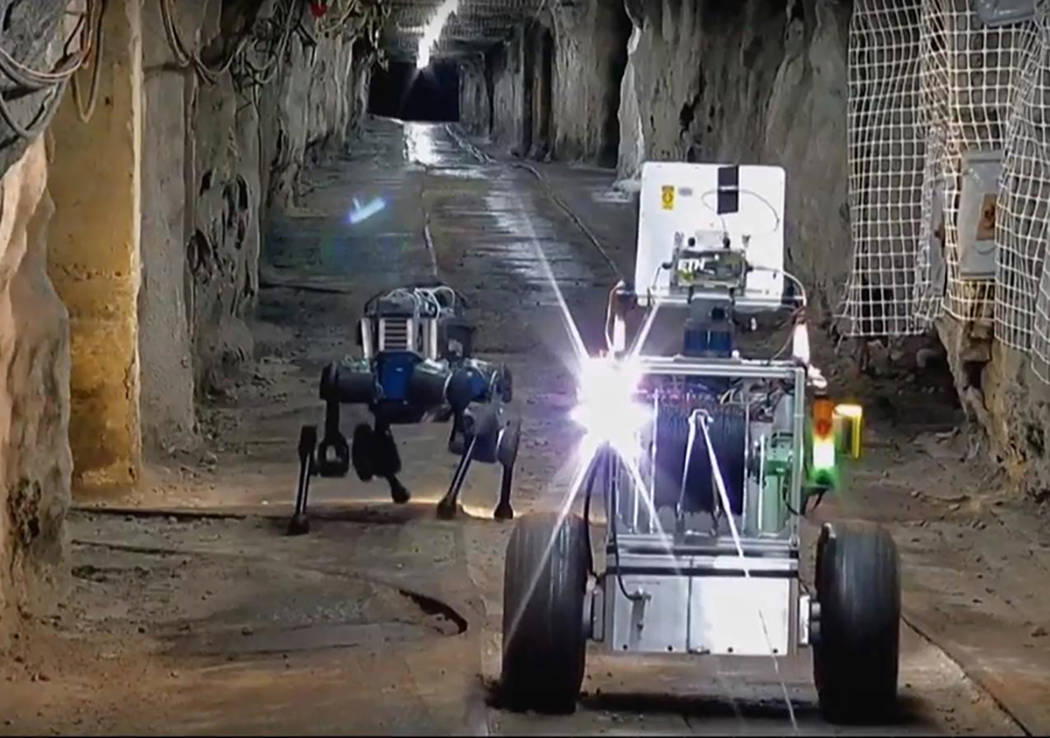
Robots that walk, fly and roll were put to the test in round one of the DARPA Subterranean Challenge navigating in a defunct mine system in Pittsburgh, Pa.– and Team CERBERUS looks forward to the next developments.
“Our team got the sixth position out of 11 outstanding teams,” said Kostas Alexis, associate professor in the Computer Science and Engineering Department at the University of Nevada, Reno.
“We knew from the beginning that our legged locomotion and flying robots approach would not be at maximum maturity – compared to, for example, wheeled platforms. We are confident, however, that our approach is the best way to go to provide a unified solution for all the environments the DARPA Subterranean Challenge is about; such as tunnels, caves, metropolitan underground infrastructure.”
CERBERUS, an international collaboration based in the College of Engineering, is one of 11 robotics teams from around the world that participated in the first round of the exclusive Defense Advanced Research Projects Agency’s DARPA Subterranean Challenge.
They brought their novel approaches to rapidly map, explore and search underground environments in time-sensitive operations critical for the civilian and military domains alike.
Led by Alexis, the CERBERUS team rolled out their technologies aimed at revolutionizing how robotic systems navigate and operate in the underground domain – human-made tunnel systems, urban underground settings and natural cave networks that are too dangerous, dark, deep and unknown to risk human lives.
The competition was held Aug. 15 to Aug. 22.
“The experience of the Tunnel Circuit of the DARPA Subterranean Challenge was unique and extremely rewarding for the whole team,” Alexis said.
“It was a combination of extreme challenge and motivation, combined with working with good colleagues and getting to know more. We are honored that we had the chance to be there.”
Their walking and flying autonomous robots are equipped with multi-modal perception systems, navigation and mapping autonomy and self-organized networked communications.
These features enable robust and reliable navigation, exploration, and mapping and object search.
A typical CERBERUS mission relates to the deployment of two-legged robots, a wheeled communications vehicle, one advanced autonomous exploration aerial robot and one collision-tolerant aerial robot.
The flying robots explore as rapidly as possible and share maps. The legged robot systems undertake the task of long-term exploration and mapping.
The deployments during the competition were based on the collaboration between all of the robots, and in most runs at least one of each were deployed.
“All competitors presented excellent research and systems,” Alexis said.
“The majority brought wheeled platforms and thus presented increased readiness and ability to score. One other team presented a combination of walking and flying robots (Team PLUTO from UPENN),” Alexis said.“A self-funded team presented a Blimp-based solution which was really cool. The teams with wheeled or tracked robots broadly scored best due to the readiness of the systems (mature technologies) and their applicability to the terrain. Carnegie Mellon University scored first with an in-house developed powerful and high-performing autonomous wheeled system. All teams presented excellent and well-performing systems.”
Team CERBERUS (CollaborativE walking & flying RoBots for autonomous ExploRation in Underground Settings) is based on the collaboration between a team of experts that, for the last few years, have been at the forefront of walking and flying robots research.
This includes Alexis, director of the Autonomous Robots Lab at the University of Nevada, Reno; Professor Marco Hutter of the Robotic Systems Lab at ETH Zurich, Professor Roland Siegwart of the Autonomous Systems Lab at ETH Zurich, Professor Mark Mueller of the HiPeR Lab at U.C. Berkeley, Maurice Fallon of the Oxford Robotics Institute Sierra Nevada Corporation based in Sparks, Nevada and Flyability based in Switzerland.
The CERBERUS team at the competition involved 19 people at the NIOSH facilities and roughly 10 more before and during the competition. There were six members from the College of Engineering and the rest were from ETH Zurich (Robotic Systems Lab and Autonomous Systems Lab), Flyability, Sierra Nevada Corp., Oxford Robotics Institute and U.C. Berkeley.
The second round of the competition, the Urban Circuit, is scheduled for early 2020, while the third round, the Cave Circuit, is scheduled to take place in August 2020. The final event, planned for 2021, will put teams to the test with courses that incorporate diverse challenges from all three environments.
Mike Wolterbeek is a communications officer at the University of Nevada, Reno.